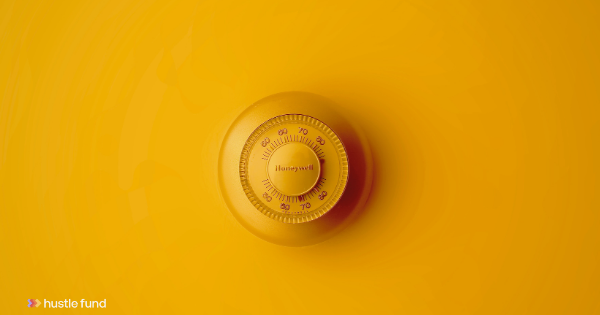Don't oversell your cap table
Picture this: You're in a meeting with a potential Series A investor.
The meeting, which was scheduled for 15 minutes, has gone way over time. Things are looking good.
Then comes the final question: "How much of your cap table have you sold?"
You answer "50%" and suddenly... the investor remembers she has a very important trip to pack for.
Over-selling your cap table can be a deal-killer. Let’s talk about why this happens to first-time founders, the implications for your business, and how to avoid it.
Let’s dive in.
Real quick: what's a cap table, again?
Let's start with the basics.
Your startup is like a pizza. When you first get started, you own the whole pizza – 100% of it.
Then you raise money from investors. In exchange for their money, the investors want a slice of the pizza.
Reasonable, right?
Your cap table is basically a list that keeps track of who owns which slices.
So if you give an investor 10% of your company for their $50K investment, they now own 1 slice out of 10 slices.
You still own the other 9 slices.
The cap table just writes this down so everyone knows: "Investor Jane owns 10%, Founder You owns 90%."
That's it! It shows investors exactly how many slices of the pizza have already been purchased – and how many slices are available to buy.
The magic number: 30%
The golden rule for seed-stage founders: aim to sell no more than 30% of your cap table before your Series A.
Why 30%?
Well, it's the sweet spot that shows you've raised enough money to prove your concept while leaving plenty of room for future investors.
Let's math:
- You raise $300K at a $1M post-money valuation
- $300K ÷ $1M = 30% of your company sold
- Series A investors see this and think: "Perfect! There's still room for us."
The danger zone
If you've sold 40%, 50%, or more of your cap table by the time you’re ready to raise your Series A, you've entered into "dirty cap table" territory.
This scares investors because…
- There’s not enough equity left for them. VCs want to own a meaningful chunk of your company (usually 15-25% in Series A). If you’ve already sold 50% of your company, there’s not enough left to go around.
- There’s not enough equity left for you. Investors want to know that you’ll stay with the business for the long haul. If your ownership percentage is too small, you might not be incentivized to stick around.
- It’ll be hard to raise subsequent rounds. Later-stage investors will face the same problem, making it hard to keep fundraising.
- Clean-up stinks. Fixing an over-sold cap table often means convincing early investors to give up some ownership. Nobody likes having that conversation.
Even if you're an amazing founder with a killer product, some VCs will pass because they don't want to deal with the mess.
They'd rather invest in an equally talented founder who has a cleaner cap table.
Why this problem exists
It can be surprisingly hard to track this stuff. Especially if you've been creative with your fundraising.
Here are some reasons founders accidentally over-sell:
Multiple SAFE rounds at different valuations
Let's say you raise $100K on a SAFE at a $1M valuation (that's 10% of your company).
Then 6 months later, you need more money. So you raise another $100K on a SAFE, but this time at a $500K valuation (that's 20% of your company).
Now you've sold 30% total, but the math gets tricky because the SAFEs convert differently. Many founders lose track and think they've only sold 20% when they've actually sold much more.
Pre-money vs. post-money confusion
Some quick definitions.
Pre-money adds your valuation to the total amount you’re raising.
- Ex: A $100K investment + $1M valuation = $1.1M pre-money valuation.
- $100K ÷ $1.1M = the investor owns about 9%.
Post-money refers to the amount your company is worth after you finish fundraising.
- Ex: A $100K investment + $900k valuation = $1M post-money valuation.
- $100K ÷ $1M = the investor owns 10%.
It's easy to mix these up and accidentally give away more ownership than you planned.
We wrote more about pre- and post-money valuations here. Worth a read.
Rolling closes
This is when you don't raise all your money at once.
Instead, you take $25K from one investor this month, $50K from another next month, and so on. Each time you add an investor, the math changes slightly.
Before you know it, you've accepted $300K from 12 different investors and suddenly realize you've sold 45% of your company instead of the 30% you planned.
The fix? Stick to standard YC post-money SAFE notes when possible. They make the math way simpler.
Here's an example:
- Round 1: Raise $100K at $1M valuation = 10% sold
- Round 2: Raise $200K at $2M valuation = 10% sold
- Total: 20% of your cap table sold (you're in great shape)
Your action items
1. Track your ownership meticulously
Create a spreadsheet with three columns: Investor Name, Amount Invested, and Percentage Owned.
Update it every single time you take money from someone. Don’t procrastinate. Do it immediately.
You can also use Carta, Fidelity, or even a Google Sheet. The tool doesn't matter. The habit does.
2. Use standard instruments
Stick to YC's post-money SAFE.
It’s free, widely adopted, and simplifies the math. You can download it from YC’s website.
Avoid weird, custom investment structures that your lawyer's cousin invented.
If you're confused about SAFEs vs. other options, read our breakdown of SAFEs and dilution – it breaks everything down super simply.
3. Plan ahead
Don't just raise money when you run out. Sit down and map out your fundraising journey.
“How much will you need for your seed round total? What about Series A?”
Work backward from your Series A goals. If you want to raise a $3M Series A and give up 20%, you need to make sure you haven't already sold more than 30% in earlier rounds.
4. Get help
Don't do this alone. Find other founders who've raised Series A and ask them about their cap table journey. Join founder groups in your city or online.
Or hire a startup lawyer and pick their brain for an hour or two. It won’t be free, but it might give you the insights you need to avoid overselling your cap table.
Your cap table is one of the most important documents for your startup's future. Keep it clean, keep it simple, and keep it under 30% before your Series A.











